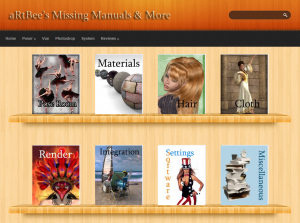Vanaf mijn eerste privé PC (1986) ben ik geinteresseerd in digitale grafische toepassingen.
 Met het beschikbaar komen van redelijke en betaalbare software en de aanschaf van mijn eerste werkstation (1996) kwamen de zaken in een stroomversnelling en breidde mijn interesse zich uit naar digitale landschappen en digitale portretten, zoals de laatste jaren gemeengoed zijn geworden in allerlei media uitingen, van reclames tot Lord of the Rings. Mijn werkstukjes zet ik op mijn site aRtBeeweb.nl.
Met het beschikbaar komen van redelijke en betaalbare software en de aanschaf van mijn eerste werkstation (1996) kwamen de zaken in een stroomversnelling en breidde mijn interesse zich uit naar digitale landschappen en digitale portretten, zoals de laatste jaren gemeengoed zijn geworden in allerlei media uitingen, van reclames tot Lord of the Rings. Mijn werkstukjes zet ik op mijn site aRtBeeweb.nl.
Na jaren van spelen, experimenteren en het maken van leuke afbeeldingen en zelfs filmpjes op muziek besloot ik in 2006 mij te gaan concentreren op enkele specifieke softwarepakketten, en werd ik ook actief in internationale forums. Daar trof ik steeds andere belangstellenden, met vaak dezelfde vragen.
Dit maakte dat ik in 2012 besloot om mijn inhoudelijke voorlichting en onderzoek een eigen plek te geven, en de site aRtBee’s Missing Manuals was geboren. In het Engels uiteraard. En net als bij mijn werkervaringen draait het hier uiteindelijk ook om tevreden ‘klanten’.
Korte statements
- I’ve used Poser for … 14 years now … and I’m learning so much just from this intro. Thank you for one of the most valuable Poser resources I’ve ever found online! (Boni Meredith, USA, July 11 2012)
- I’ve just discovered your site. Thank you for that. Everything helps me a lot on and so many secrets about Poser is out now for me thanks to your help. (Hanna W, Germany, August 08 2012)
- What a great idea. Thank you. The hair room has a scarry feel to it until you know what to do. This is a great help. (John Allan, USA, Oct 04 2012)
- Excellent work as usual. (Bill Norton, Texas, Nov 16 2012)
- Awesome! You do some great tuts so these will really help. (3DFineries, Florida, Sept 06 2012 on Renderosity)
- I’ve found them very informative, and like the way your approaching them. (GeneralNutt, UK, May 07 2012 on Renderosity)
Lang statement
” I stumbled upon these tutorials last week and wanted to comment on them at that time, but this is probably the better thread anyway.
As much as I complain about the poor quality of documentation and tutorials for Poser (and for almost any other app for that matter), I feel I should point out when someone gets it right, and that’s the case here. These tutorials are excellent in and of themselves, but beyond that they should be studied by those in charge of documentation at Smith Micro or anyone wanting to write a tutorial.
So what does aRtBee get right? Well, he starts by addressing what I consider the first rule of technical writing: know who your audience is and speak to them. That’s the first thing that aRtBee does:
“Who are You?
“You are an ‘experienced beginner’ or intermediate user of Poser, Vue, Photoshop or alike and you have some basic understanding of image handling software like Photoshop, GIMP or alike. It’s installed, runs without serious errors, you’ve got some results out in print or your website or a web gallery, and you may have read some parts of the user manual, done some tutorials and visited some forums.
“Now you want to improve yourself, enhance the quality of your results and the efficiency and effectiveness of your way of working. But where to start?”
Excellent. Right away he’s defined the intended audience for the tutorials, so people won’t waste their time on something that’s either too advanced or too basic.
The next thing he does is address my second rule of technical writing: don’t just tell me what something does; tell me what its purpose is. Tell me what problem it solves, why I would want to use it, and when I would want to use it. aRtBee speaks to that also in the introduction and talks about the difference between manuals and tutorials and what their limitations are.
“Manuals tend to follow the menu structure and screen layout. But they hardly tell me when to use a specific function, and in which case what parameter settings are preferred. The menu structure never is the structure of my workflow. Manuals might help with the work but hardly contribute to the flow.
“Tutorials tend to direct me to a specific result, and tell me which buttons to push and which parameters to set. But only in rare cases they tell me why. Tutorials might help with the flow, but hardly contribute to my next piece of work.”
This is carried forward into the lessons themselves. For example in the “Poser Render Passes” lesson he spends the first two paragraphs laying out a problem inherent In Poser: time consuming renders. He then gives an overview of the overall approach he uses to deal with that problem and follows that with a summary of the basic steps needed to solve the problem. All that before he’s given a single do-this-do-that instruction.
So that, in my opinion, is how it should be done. Identify your audience, identify the problem, and focus on the why, not the how. ”
(ElZagna, May 07 2012 on Renderosity)
 HCC – begonnen als Hobby Computer Club – is een vereniging van computergebruikers, opgericht rond 1982 toen de basismodellen Amiga en Commodore hun intrede deden. De vereniging maakt in zijn ontwikkelingen alle turbulenties mee die het computer-landschap kenmerken:
HCC – begonnen als Hobby Computer Club – is een vereniging van computergebruikers, opgericht rond 1982 toen de basismodellen Amiga en Commodore hun intrede deden. De vereniging maakt in zijn ontwikkelingen alle turbulenties mee die het computer-landschap kenmerken: